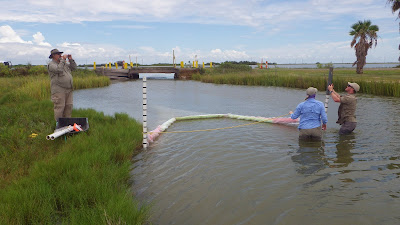American eels undergo one of the most remarkable journeys from the Sargasso Sea to coastlines from Greenland to South America.
These migrating eels make their way into coastal waters as small, transparent glass eels. They then develop pigment and become known as elvers, as they take up residence in estuaries or swim up rivers.
Elvers continue to grow into yellow eels and live for many years before transforming into sexually mature silver eels to make their long journey back to the Sargasso Sea where they spawn and presumably die.
Along the East Coast of the United States, the arrival of glass eels is fairly predictable; however, here in Texas and across the Gulf of Mexico, we are still wondering when American eels make it to our waters. Researchers from the University of Houston-Clear Lake (UHCL) teamed up with TPWD to sample for juvenile American eels across the Texas Coast using a wide variety of gear types with the hope of answering this question.
From 2018-20, UHCL led an effort to sample for glass eels and elvers using small-mesh fyke nets in tidal creeks from Corpus Christi Bay to Sabine Lake. These nets were set overnight to fish one incoming tide. Small fish and invertebrates, such as shrimps and crabs, were funneled into the cod end of the net until they could be checked the next morning. These nets were set in the water 330 times across 130 unique sites during the study period.
 |
| Justin Hansen, Jenny Oakley, and George Guillen with the University of Houston-Clear Lake eploying a fyke net in a tidal creek. |
During the same time that fyke nets were in the water, volunteers with the Texas Master Naturalists were also sampling along the coast for juvenile American eels using eel mops, a funny-looking device that sits on the bottom of a creek or bayou to mimic vegetation that tiny eels utilize. Eel mops were continually deployed at a single site anywhere from 5 to 25 months and checked once a week.
Additionally, UHCL decided to sample with eel mops in year two of their study at the same sites where they were setting fyke nets. In total, eel mops were deployed across 24 different sites and checked almost 300 times.
 |
| Pete Romfh with the Cradle of Texas Chapter and Erik Extrell with the Alamo Area Chapter of the Texas Master Naturalists check and deploy an eel mop. |
Despite this intensive sampling effort, no American eels were collected using fyke nets or eel mops. However, along with many different species of fish and invertebrates, speckled worm eels were collected in both fyke nets and eel mops. This species undergoes a similar life cycle as American eel but on a smaller scale. Many of the individuals of speckled worm eel collected were in their glass eel stage.
UHCL graduate students Justin Hansen and Tito Molina spent much of their time sorting through and carefully inspecting these juvenile eels since both American eels and speckled worm eels swim into bays and estuaries at the same time in other parts of the country. While speckled worm eels were not our target species, the collection of these individuals is reassuring because it tells us that our gear types successfully collected another species with a similar life history.
 |
| A speckled worm eel collected using a fyke net. |
Although our sampling effort with fyke nets and eel mops has concluded, we’re not ready to give up! TPWD has partnered again with UHCL to set up a network of eel ramps along the mid to upper Texas Coast. Eel ramps are a popular sampling gear used on the East Coast to collect juvenile American eels.
UHCL field research technicians Ashlyn Sak and Erica Underwood have led the charge in constructing and deploying eel ramps at 11 sites. These ramps will be deployed for one year and checked weekly for juvenile American eel. In addition, water samples will be collected at a subset of these sites to test for American eel DNA to see if the species is present at the site.
 |
| Ashlyn Sak and Erica Underwood with the University of Houston-Clear Lake checking an eel ramp. |
Stay tuned to hear more about the work that we are doing to better understand the unique life history of this species in Texas. You can also follow us on Facebook (@TexasRiversStreams) and Instagram (@texasriversstreams) for project updates. Check out this project along with other research being conducted by UHCL at https://www.uhcl.edu/environmental-institute/
If you want more content like this, subscribe to Texas Parks & Wildlife magazine. Whether in print or through our mobile app, choose the version that works best for you.
